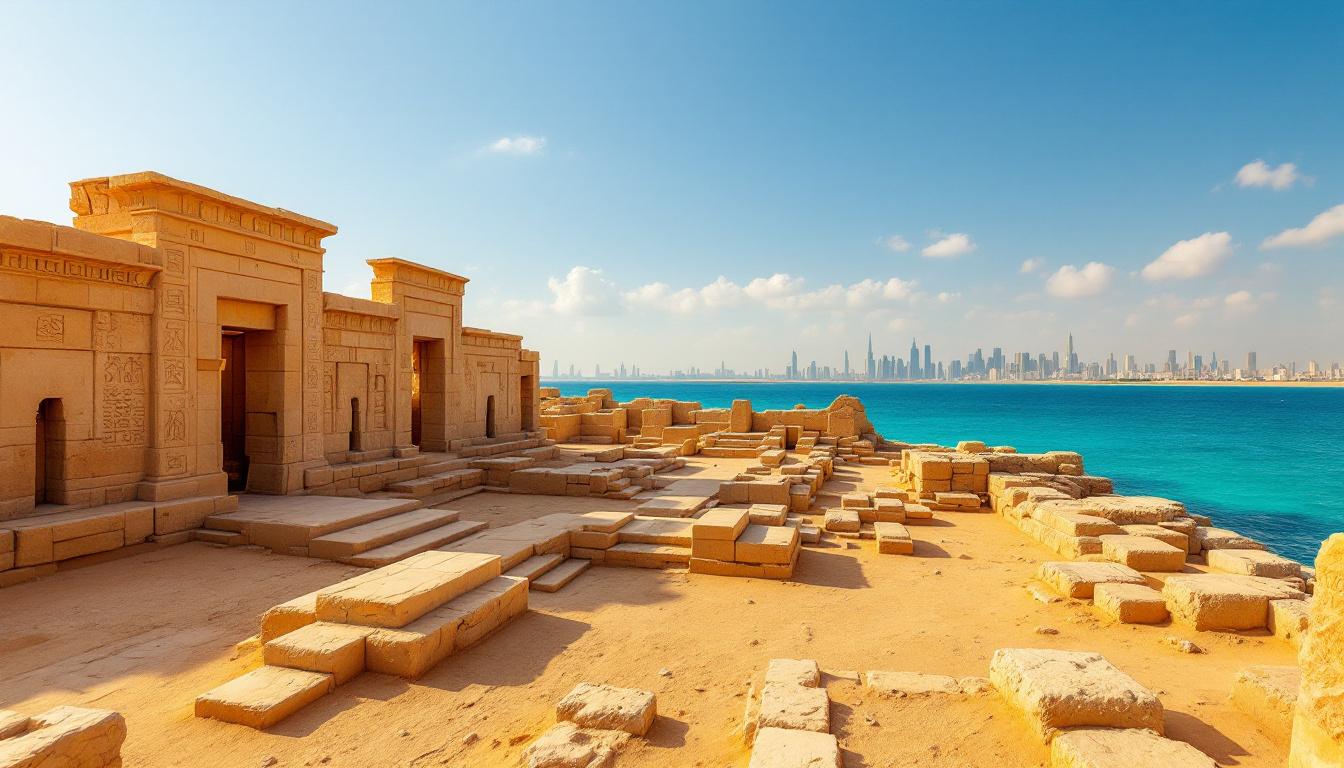Standing on the deck of the ferry approaching Failaka Island, twelve miles off Kuwait City’s coast, I realized I was about to explore something genuinely unique in the Gulf region. This is the only destination where you can walk through 4,000-year-old Bronze Age temples in the morning and attend world-class performances at the Middle East’s largest cultural center by evening.
While Dubai builds its reputation on futuristic skyscrapers and Doha showcases modern museums, Kuwait City quietly guards an archaeological treasure that predates both cities by millennia. The newly discovered Bronze Age Dilmun temple from 1900-1800 BC represents just one layer of continuous human habitation spanning four thousand years.
What struck me most was the realization that this Gulf capital offers experiences you literally cannot find anywhere else in the region. No other major Arabian city provides this depth of historical continuity combined with cutting-edge cultural infrastructure.
The archaeological wonder that redefines Gulf heritage
Bronze Age discoveries that shocked international experts
In November 2024, Danish-Kuwaiti archaeologists uncovered an 11-by-11-meter Bronze Age temple containing multiple altars on Failaka Island. Dr. Stephen Larsen from Denmark’s Mosgard Museum confirmed this discovery provides crucial evidence of human settlement 4,000 years ago, making it the oldest verified temple structure in the Gulf region.
Hellenistic treasures revealing ancient trade networks
The February 2025 discovery of a 2,300-year-old Hellenistic courtyard at Al-Qurainiya site unveiled plastered walls and pottery artifacts suggesting this was a major administrative center during Seleucid Empire rule. These findings demonstrate Kuwait’s position as a crucial Persian Gulf trading hub when most regional areas remained undeveloped.
The cultural institution that dwarfs regional competitors
Middle East’s largest performing arts complex in unexpected location
The Sheikh Jaber Al-Ahmad Cultural Centre covers more ground than any comparable institution from Riyadh to Tehran, featuring multiple theaters and galleries. While other Gulf capitals focus on commercial attractions, Kuwait invested in genuine cultural infrastructure that serves both residents and visitors seeking authentic artistic experiences.
Programming that rivals European capitals
International orchestras, traditional Arabic performances, and contemporary art exhibitions rotate through spaces designed by leading architects. The center’s scale and programming ambition exceed what you’ll find in Dubai’s scattered cultural venues or Doha’s single-focus museums.
The authentic experiences mass tourism hasn’t discovered
Traditional souks operating as they have for centuries
Souq Al-Mubarakiya maintains its authentic character because tourist crowds remain manageable compared to Dubai’s commercialized markets. Local artisans still practice traditional Bedouin weaving at Sadu House, preserving cultural techniques that disappeared elsewhere due to tourism pressures.
Island access requiring insider knowledge
Reaching Failaka Island’s 90+ archaeological sites requires advance planning and boat transportation, naturally limiting visitor numbers. This protection means you’ll explore ruins without crowds, experiencing genuine archaeological wonder rather than managed tourist attractions.
The practical advantages other Gulf capitals can’t match
Cost benefits that surprise international travelers
Accommodation and dining costs run 20-30% lower than Dubai or Doha, while cultural experiences offer superior depth. The Sheikh Jaber Cultural Centre’s ticket prices remain accessible compared to premium entertainment elsewhere in the region.
Climate timing that works better than southern neighbors
Kuwait City’s optimal visiting season extends from October through April, offering comfortable temperatures when you’re exploring outdoor archaeological sites. The timing aligns perfectly with cultural center programming and allows full appreciation of both historical and contemporary attractions.
Essential planning for archaeological and cultural exploration
How to access Failaka Island’s restricted sites
Book ferry transportation through licensed operators and confirm archaeological site access with Kuwait National Museum guides. The island’s protection means advance planning ensures you experience active excavations where international teams continue making discoveries.
Cultural center programming that requires advance booking
Major performances at Sheikh Jaber Al-Ahmad Cultural Centre sell out quickly among Kuwait’s cultural enthusiasts. Check programming schedules and book tickets before arrival to guarantee access to Middle East’s premier cultural venue.
Respectful exploration in Islamic cultural context
Modest dress requirements apply at religious sites including the Grand Mosque, Kuwait’s largest. Understanding local customs enhances both archaeological and cultural experiences while showing respect for communities protecting these treasures.
Kuwait City reveals itself as the Gulf’s most authentic cultural destination precisely because it hasn’t been discovered by mass tourism. The combination of Bronze Age archaeology and world-class contemporary culture creates experiences unavailable anywhere else in the Arabian Peninsula.
This capital city proves that the most remarkable destinations often hide in plain sight, waiting for travelers who appreciate depth over superficial attractions.
